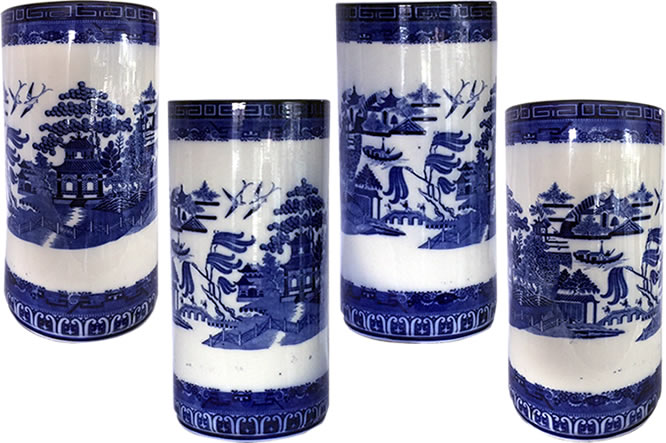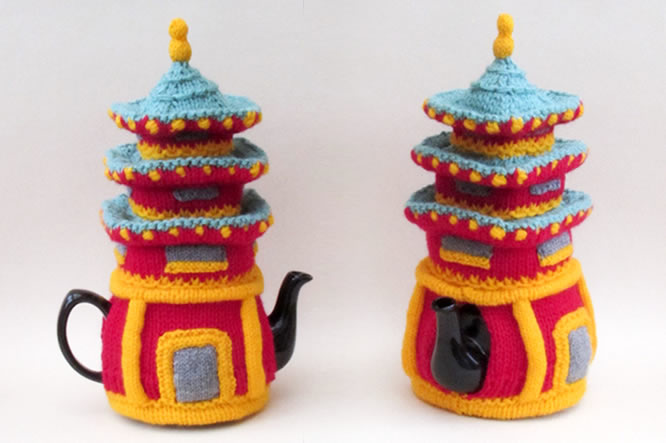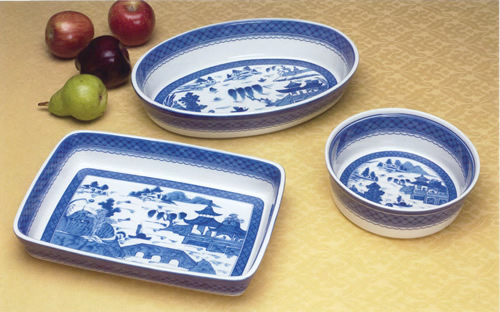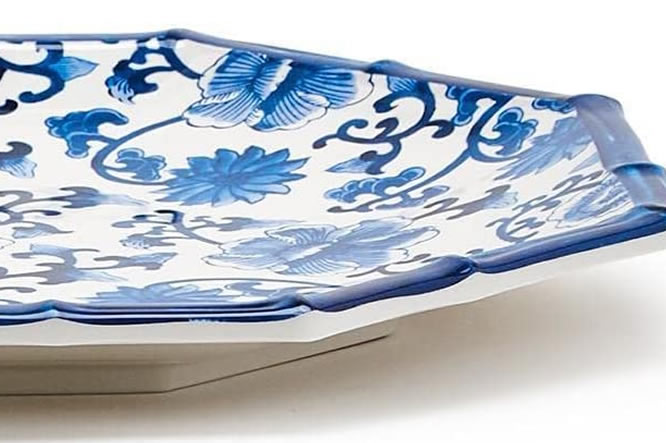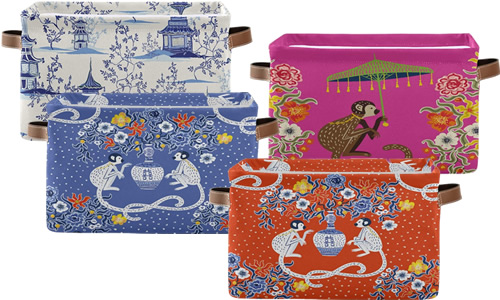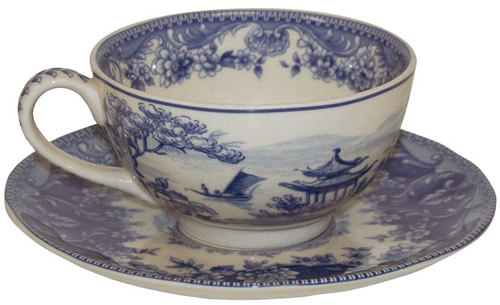Traditional Chinese Vases and Other Vessels – Part 1
If you collect Chinoiserie, you hear a lot of different names for the different shapes and patterns. This is what some of these words mean.
The shape of a piece of china doesn’t really tell you how old it is. The same forms last for centuries.
Not all Chinoiserie is porcelain. They can also be other types of pottery, jade, other precious stones or metal. Often they originally had lids, although lids get lost. The same basic shape has many variations, with and without handles.

Lidded ritual wine container (hu) with masks and dragons; China; Late Shang dynasty, ca. 13th century B.C.E.; Bronze
Freer Gallery of Art
China Bronze Vessel Nbronze Fang Hu Wine Vessel Late Eastern Zhou 4Th Century BC
Posterazzi Poster Print on Amazon
Hu Wine Vessels
One of the earliest ceramic forms, the hu harks back to before the Shang dynasty (1600-1045 BCE). First made in pottery, the hu evolved into the bronze form as a ritual wine vessel with a pear-shaped cross section, swelling at the belly, then flaring at a narrow neck, creating an S-shape profile… In the Qing dynasty Kangxi period (r. 1662-1722), the shape would appear in porcelain with holes around the foot…
The Origins and Evolution of Chinese Ceramic Shapes, Sothebys
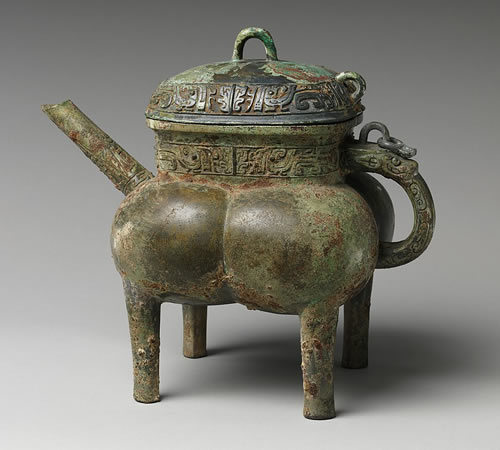
12th–11th century BC
Bronze with green patina
Asian Art Gift of Mrs. Edward S. Harkness
Metropolitan Museum of Art
He Wine Kettles
… This form appeared in the 11th-10th century BCE as a bronze ritual wine vessel, often found in tripod form and later evolved into animal-form vessels on four legs…
…scholar Wang Guowei (1877-1927) described… banqueters… diluting wine using water poured from a he.
The Origins and Evolution of Chinese Ceramic Shapes, Sothebys

Prunus Vase with Inlaid Lotus and Reed Design
Celadon ware with inlaid white and black slip decoration
Meant to hold a single branch of plum tree blossoms.
Korea, Goryeo period (936-1392)
Cleveland Museum of Art
Meiping vase with plum blossoms and bamboo – China
Porcelain painted in overglaze famille rose enamels
First half of the 19th century
Metropolitan Museum of Art
Meiping, Plum or Prunus Vases
Earliest examples produced in the Tang dynasty (618-907) were used as wine jars, but by the Song dynasty (960 – 1279) they were used to display plumb blossoms. Meiping translates into plumb vase. It was considered to be the perfect shape to hold a plumb branch. It has a narrow mouth, a small neck resting on high broad shoulders and a tall body tapering off to a shallow foot ring.
A Guide To Chinese Antique Vase Shapes
Irv Graham Chinese Antique Appraisals
The meiping originated in the Tang dynasty (618-907) as a wine storage vessel often found in tombs. Later the shape was used for decorative vases during the Song dynasty… The name ‘plum vase’ comes from the use of placing plum blossoms in the vase. The body is tall and slender with a short narrow neck, broad rounded shoulders, tapering to a narrow base. They sometimes had lids, which were often lost, and variations include hexagonal meiping vases.
The Origins and Evolution of Chinese Ceramic Shapes, Sothebys

Yongzh – Pear-Shaped Vase
Qing dynasty (1644-1912)
Porcelain with underglaze blue decoration
Cleveland Museum of Art
Pear-shaped vase (yuhuchunping) with lotus and banana leaf motifs in copper-red, China
Hongwu period (1368-1398), Ming dynasty
Porcelain with underglaze copper-red, metal
Newark Museum
Photo by W M Pearl
Yuhuchunping, Pear-Shaped Vases
With its long slender neck and gentle curves outlining its elegant silhouette, the form of this vessel in Chinese is called yuhuchun (‘spring in a jade bottle’).
A blue and white ‘figural’ vase, Yuhuchunping, Yuan dynasty, Sothebys
First produced for temples in the Tang dynasty 618-907 to hold water. The shape was popularized during the Song dynasty 960-1279 as wine vessels. This tradition went on right up until the Qing dynasty. It is characterized by a slight flared rim, a straight neck that broadens at the end, a bottom heavy body and short foot ring.
A Guide To Chinese Antique Vase Shapes
Irv Graham Chinese Antique Appraisals
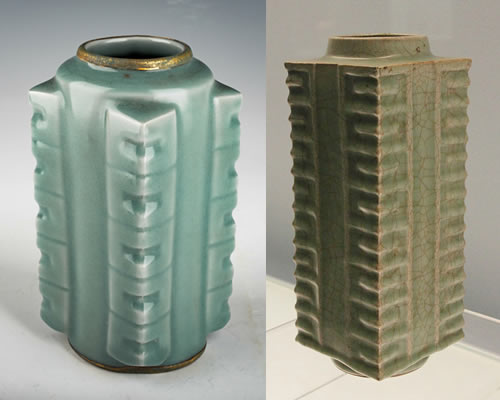
Imperial Ru Ware 2nd comm. Cong vase
Photo by Joe Sharon
Celadon cong-shaped vase, Longquan ware
1127~1279 A.D.,
Shanghai Museum
Photo by Zhangzhugang
Cong Vases
A square-shaped vase with a short neck and a flat base, the cong is one of the oldest Chinese vessels. It may be made of pottery or porcelain or even jade or other precious materials.
Jade congs came in many sizes and were often found in tombs. Their original function is unknown. The shape came back into vogue during the Song 960-1279 and Yuan 1271-1368 dynasty’s then again during the Qianglong period 1736-1795 and again became popular in the 19th century as a porcelain form. The original shape is a square, rising from a short circular foot and surmounted by a short circular neck.
A Guide To Chinese Antique Vase Shapes
Irv Graham Chinese Antique Appraisals
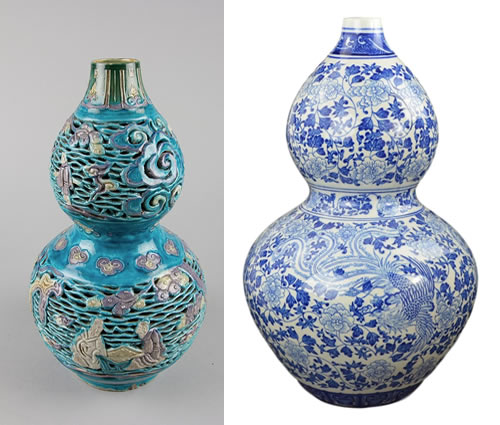
Porcelain decorated with pale aubergine, yellow, and beige glazes on blue ground
Metropolitan Museum of Art, Bequest of John D. Rockefeller Jr.
Classic Blue and White Porcelain Gourd-Shaped Vase, China Ming Style with Phoenix and Flower Pattern Jingdezhen, Festcool Store, Amazon
Huluping Double-Gourd Vases
The double-gourd vase, hulu ping, is based on the hourglass-shaped gourd vegetable.
The Origins and Evolution of Chinese Ceramic Shapes, Sothebys
The shape of the double gourd was derived from the gourd plant itself during the Southern Song dynasty. Gourds were thought to have mystical healing properties and are a fertility symbol. They are also a Daoist emblem of immortality. Then during the Kangxi period, triple gourds examples were made.
A Guide To Chinese Antique Vase Shapes
Irv Graham Chinese Antique Appraisals
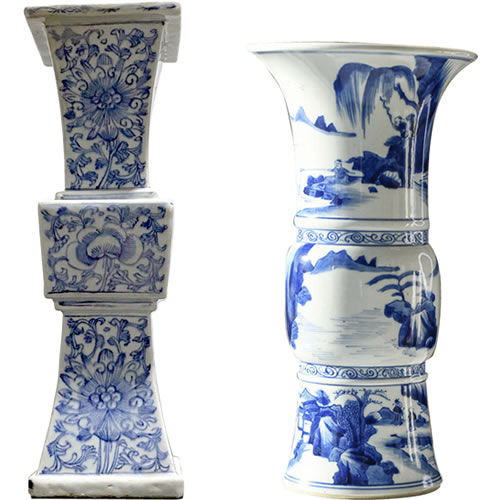
Cobalt Blue on White Porcelain
Gu, Beaker Vase, Flaring Vases
Gu “beaker-form” vases are wider at the bottom, narrow in, then have a bulbous mid-section and a flaring neck.
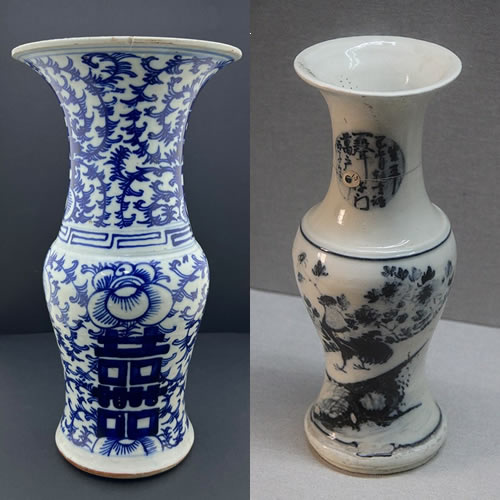
Chinese Blue-White Phoenix Tail Yen Yen Vase, Late Qing Dynasty
Porcelain Gallery, Xinzheng City Museum, Henan Province, China
Photo by Gary Todd
Fengweizun, Phoenix-Tail Vase, Yen-Yen Vase
Fengweizun’s shape was inspired by the Gu Vase. However, it has a more widely flaring, trumpet neck, resembling a phoenix tail, and a heavier body at the bottom.
A Beginner’s Guide to Chinese Porcelain Vase Shapes
For the novice collector, a helpful guide for identifying Chinese vases.
Art World Helen Bu, July 15, 2014
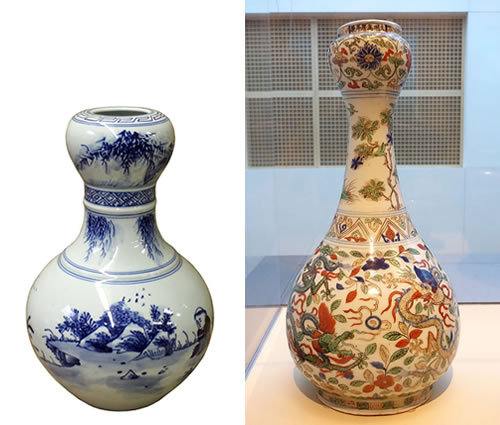
Chinese Blue White Porcelain Scenery Suantouping Garlic-Mouth Vase
Orient Living Store on Amazon
Vase with mouth in the shape of a garlic bulb, China, Jiangxi province, Ming dynasty, Wanli emperor, porcelain with underglaze and overglaze polychrome decoration
Asian Art Museum of San Francisco
Photo by Daderot
Suantouping, Garlic-Mouth Vase, Garlic-Head-Shaped Vases
The garlic head shaped vase was first produced in bronze during the Han dynasty (206BC – 220AD). The body of the vase is pear-shaped, with a slender neck rising to a garlic bulb shaped mouth. The porcelain type were produced in the Ming dynasty (1368 – 1644)
A Guide To Chinese Antique Vase Shapes
Irv Graham Chinese Antique Appraisals
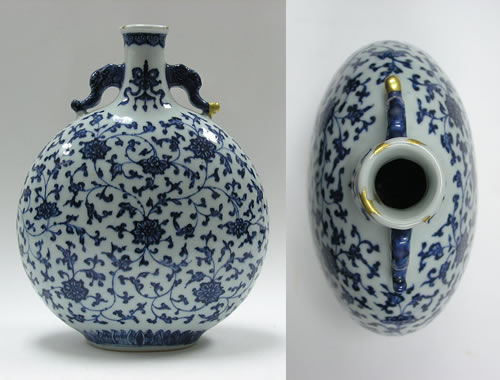
Flask, gourd shaped pilgrim bottle with gold repairs
Qianlong, 1736-1795-Qing dynasty (1644-1912)-Chinese Dynasty and Reign Periods; Circa 1750; 1968
Arts of Asia Gallery
Auckland Museum Tamaki Paenga Hira
Gift of Charles Edgar Disney Art Trust
Baoyueping, Bianhu, Moonflask, Pilgrim Flasks
Moon flasks were first produced during the Ming dynasty 1368-1644 and the shape was based on Middle Eastern vessels of gold and silver. The word “Baoyue” means ’embracing the moon’ They are characterized by a circular flattened body, a flat base, a narrow cylindrical neck and two arched handles on the side.
A Guide To Chinese Antique Vase Shapes
Irv Graham Chinese Antique Appraisals
… Ming dynasty Yongle period that ceramic shapes copied Middle Eastern metalwork brought into China by traders and tribute bearers… the moonflask, with its circular body, domed on one side and flat on the unglazed reverse, opening at the top with a short neck and narrow mouth. Some Ming versions have the compressed spherical body on both sides.
The Origins and Evolution of Chinese Ceramic Shapes, Sothebys
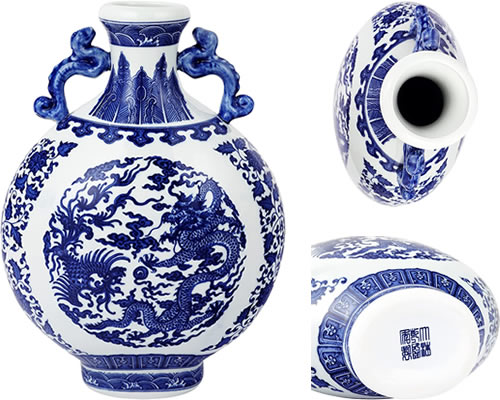
Blue and White Porcelain Classic Binaural Vase in Chinese Dragon Pattern
Fanquare Store on Amazon
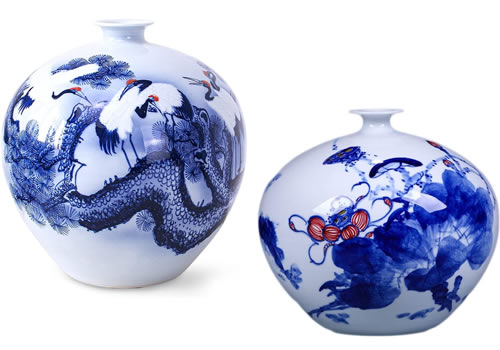
Dahlia Blue and White Vase, Hand Painted Chinese Porcelain Flower Vase, Shiliuzun, Pomegranate Vases
Certified Masterpiece Longevity Cranes, Pomegranate Shape
the Dahlia Store Amazon
Small Pomegranate Shape Vase
Yanybing Store Amazon
Shiliuzun, Pomegranate Vases, Apple Vases
This vase originated in the Yongzheng period (1722 – 1735) during the Qing dynasty. Its form was taken from the pomegranate. The vase is a symbol of happiness and fertility. It has a globular body, sweeping up to a short flared neck.
A Guide To Chinese Antique Vase Shapes
Irv Graham Chinese Antique Appraisals
Shiliuzun have a round body and a short neck to match the shape of a pomegranate. These vases began to be made in the Yongzheng period (1722 – 1735) of the Qing dynasty.
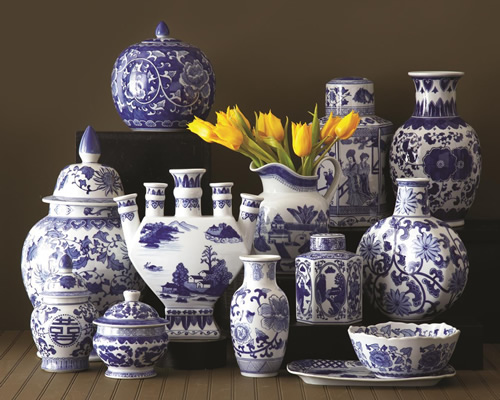
Discover more from my design42
Subscribe to get the latest posts sent to your email.

